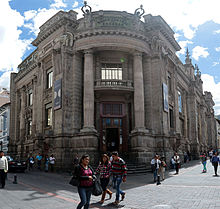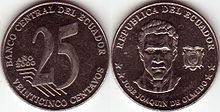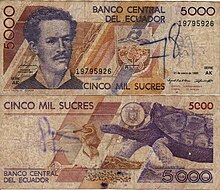Ecuadorian sucre
| Sucre | |
|---|---|
| Country: | Ecuador |
| Subdivision: | 100 centavos |
| ISO 4217 code : | ECS |
| Abbreviation: | S /. |
|
Exchange rate : (September 2000) |
1 USD = 25,000 ECS |
The sucre is the former currency of Ecuador . The sucre was issued by the Banco Central del Ecuador , the country's central bank . In September 2000, the US dollar replaced the sucre as the only valid currency in the country. The ISO code of Sucre was ECS . A sucre was divided into one hundred centavos .
history
Colonial times
The cultures ruled by the Incas at the time of the colonization of South America in the area of today's Ecuador knew no currency; outside the Inca empire, trade was based on barter transactions. Within the Inca Empire, the economy was based on a collective system.
The first currency in America was introduced with the Spanish. The Spanish coins were based on a figure-of-eight system. Commonly used were real , pesos (= 8 silver-real), PTE (= 2 Pesos) and Doubloon (= 2 PTE).
The first American mint was the Casa de Moneda de Mexico (1535), the first mint in South America was the Casa de Moneda de Lima (1565). Up until independence, further mints were founded in Potosí , Santa Fe de Bogotá , Cartagena , Caracas and Popayán (moved to Pasto in 1821 ). After the independence of the Republica de Colombia (Greater Colombia) , the Spanish currency system was retained. Since the local mints could not meet the demand, Peruvian, old Spanish and coins from all over the world were mainly used in what is now Ecuador.
Casa de la Moneda de Quito
From the collapse of Greater Colombia, Ecuador emerged as an independent republic in 1830. In 1832 the Casa de la Moneda de Quito was founded. Before our own coins were minted, Colombian coins were given the initials MDQ and legalized for circulation in Ecuador.
The first coins minted in Quito continued to use the Spanish figure of eight and the coat of arms of Colombia with the designation "El Ecuador en Colombia". In 1836 the first coins with the designation República del Ecuador were minted. Due to the poor minting quality of the coins, they were hardly distinguishable from the counterfeits that were increasingly in circulation, which even led to counterfeiting being legalized by the government in 1842.
A law passed in 1856 provided for the introduction of the decimal system adopted by France with a transition period until 1866. But in 1858 the last reserves of the Casa de la Moneda de Quito were used up to produce 5-franc coins, whereupon the mint was closed and the franc withdrawn.
From 1861 the Banco de Guayaquil was authorized to produce coins according to the old system and with the final introduction of the decimal system from 1872 the Banco del Ecuador was authorized to produce centavos of the peso . This is also the time when the first banknotes were issued by various banks.
Sucre
The sucre was introduced as a currency in Ecuador on March 22, 1884 . It is named after Marshal Antonio José de Sucre , a colleague of Bolivar during the South American struggle for independence. On May 24, 1822, Sucre defeated the Spanish troops in the Battle of Pichincha , which resulted in the independence of Quito and the territory of the province of Quito as the colonial forerunner of Ecuador.
Various banks have been authorized to produce sucres. The coins are minted in Birmingham , Santiago de Chile , Lima or Philadelphia . From 1898 the monetary system was tied to the gold reserves, and gold coins with the denomination Cóndor Ecuatoriano with a value of 10 sucres were minted.
Private central banks
From the bankruptcy of the Casa de la Moneda de Quito to the founding of the central bank, various private banks were authorized to mint coins and issue banknotes. Some of the banks of that time were Banco de Descuento y Circulacion , Banco Internacional , Banco de Guayaquil , Banco del Ecuador and Banco Comercial y Agricola in Guayaquil and Banco Unión , Banco de Quito and Banco del Pichincha , which still exists in Quito.
After the fall and later murder of Eloy Alfaro , very economically liberal forces from the coastal region came to power, and thus in fact the banks they ran, especially in Guayaquil. In the 1910s and 1920s, the Banco Comercial y Agrícola was seen as a key institution in the nomination of promising presidential candidates. The banks are criticized in the Ecuadorian historiography for having minted coins and printed banknotes without support in the country's precious metal reserves, which contributed decisively to a total collapse of the Ecuadorian economy in the early 1920s. In 1925, the government was overthrown by a military coup that went down in history as the July Revolution . The following year, Isidro Ayora was elected the new president, who had previously served as part of a government installed by the military.
Banco Central del Ecuador
Planning for a state-organized currency system with a central bank began during the military junta. Ayora put these plans into practice, and on August 10, 1927, the central bank, Banco Central del Ecuador , which still exists today, was inaugurated. From now on, coins and banknotes were issued exclusively by the central bank. All coins in circulation were replaced with new ones. Even today, the word Ayoras is used in everyday language as a synonym for change. Coins minted from one centavo to 2 sucres and notes from 5 to 100 sucres printed by the American Bank Note Company were introduced in Birmingham and Philadelphia . From 1944 onwards, 500 and 1000 sucres notes were also put into circulation.
Ecuador went through various political and economic crises in the 20th century. After a brief boom caused by the oil crisis in the 1970s, the Ecuadorian economy fell steadily and exponentially from the mid-1990s. As a result of inflation, ever larger notes were issued and smaller denominations were replaced by coins. In 1987, 5,000 sucres notes were introduced, from 1989 coins replaced denominations of 5, 10, 20 and 50 sucres, and the first 10,000 sucres notes were issued. In the early 1990s, the centavos and 1-sucre coins disappeared due to their low value. From 1995, the 100, 500 and 1000 sucres notes were replaced by coins and 20,000 and 50,000 sucres notes were introduced.
Dollarization
In early 1999 , $ 1 was equivalent to about 6,500 sucres. With an inflation rate of over 90%, the value had dropped to a fifth of this value by the end of the year. The shortly thereafter deposed Ecuadorian President Jamil Mahuad proposed on January 9, 2000 that the sucre be abolished in favor of the US dollar . This proposal was retained and carried out by his successor Gustavo Noboa . When the US dollar was introduced ( dollarization ), the population was able to exchange their savings to the value of 25,000: 1 in a transition phase. Due to the incorrect determination of the exchange rate (45,000: 1 would have been about the correct rate) and the associated sharp increase in the (dollar) money supply , US dollar inflation occurred temporarily. Nevertheless, dollarization soon brought an end to high inflation .
On September 9, 2000, the sucre was finally replaced by the US dollar. In addition to the US notes and coins used, Ecuador continues to mint its own small coins with the denomination centavo, which correspond to the US cents in size and weight. The official designation for these coins is "Centavos del Sucre" whereby it is specified that 100 Centavos correspond to 25,000 sucres (and thus one US dollar) (see also: Coins of Ecuador ) . Although the official currency is the US dollar, the sucre still exists under the law.
Coins & Banknotes
Sucre coins and banknotes were in circulation from 1884 until the dollarization in 2000. Since 1927, coins and banknotes have been issued exclusively by the Banco Central del Ecuador . Due to the exponential devaluation of the sucre that began in the late 1970s , the denominations 5 to 50 sucres were replaced by coins in the late 1980s and the denominations 100 to 1000 sucres in the mid-1990s. The 50 Centavos and 1 Sucre coins, which were still minted in 1988, disappeared from circulation shortly afterwards due to their low value. In the late 1980s, 5,000 and 10,000 and in the mid-1990s, 20,000 and 50,000 sucres notes were introduced.
After dollarization, Centavos del Sucre were issued in par with US cents with denominations from 1 to 50 centavos . In addition, US notes and coins - including the 1 dollar coin, which is rarely used in the US - are in circulation. More information about these coins can be found in the article “ Coins of Ecuador ” .
Last series of Sucres coins
| Face value | image | front | back | material | Weight | diameter | Mint |
|---|---|---|---|---|---|---|---|
| 50 centavos |
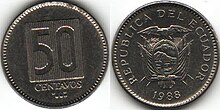
|
50 centavos | Coat of arms of Ecuador | nickel-plated steel | 2.95 g | 18 mm | Royal Canadian Mint |
| 1 sucre |

|
Antonio José de Sucre | Coat of arms of Ecuador | nickel-plated steel | 3.05 g | 20 mm | Royal Canadian Mint |
| 5 sucres |

|
Banana stalk | Coat of arms of Ecuador | nickel-plated steel | 5.25 g | 22 mm | Royal Canadian Mint |
| 10 sucres |

|
Valdivia Venus | Coat of arms of Ecuador | nickel-plated steel | 6.25 g | 24 mm | Royal Canadian Mint |
| 20 sucres |
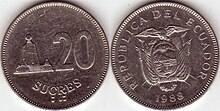
|
Mitad del Mundo | Coat of arms of Ecuador | nickel-plated steel | 8.25 g | 26 mm | Royal Canadian Mint |
| 50 sucres |

|
Sun mask of the Tolita culture (landmark of Banco Central ) | Coat of arms of Ecuador | nickel-plated steel | 8.55 g | 28 mm | Royal Canadian Mint |
| 100 sucres |

|
Antonio José de Sucre (1997: 100 ) | Coat of arms of Ecuador (1997: Antonio José de Sucre ) | Bimetal | 3.6 g | 19.5 mm | German Nickel AG |
| 500 sucres |

|
Isidro Ayora (1997: 500 ) | Coat of arms of Ecuador (1997: Isidro Ayora ) | Bimetal | 5.7 g | 21.5 mm | German Nickel AG |
| 1000 sucres |

|
Eugenio Espejo (1997: 1000 ) | Coat of arms of Ecuador (1997: Eugenio Espejo ) | Bimetal | 7.2 g | 23.5 mm | German Nickel AG |
Last series of Sucres banknotes
| Face value | image | front | back | size | First edition (last print) |
|---|---|---|---|---|---|
| 5 sucres | Antonio José de Sucre | coat of arms | 156 × 66 mm | 1983 (1992) | |
| 10 sucres | Sebastian de Benalcazar | coat of arms | 156 × 66 mm | 1988 (1992) | |
| 20 sucres | La Compañía de Jesús Church, Quito | coat of arms | 156 × 66 mm | 1988 (1992) | |
| 50 sucres | Monumento a la Independencia, Quito | coat of arms | 156 × 66 mm | 1988 (1992) | |
| 100 sucres | Simon Bolivar | coat of arms | 156 × 66 mm | 1992 (1992) | |
| 500 sucres | Eugenio Espejo | coat of arms | 156 × 66 mm | 1992 (1992) | |
| 1000 sucres | Rumiñahui | coat of arms | 156 × 66 mm | 1992 (1992) | |
| 5000 sucre | Juan Montalvo and coat of arms of the Tungurahua Province | Galapagos cormorant , penguin and turtle | 156 × 66 mm | 1987 (1995) | |
| 10,000 sucre | Vicente Rocafuerte | Quito : Independence Monument and Presidential Palace | 156 × 66 mm | 1988 (1996) | |
| 20,000 sucre | Gabriel García Moreno | coat of arms | 156 × 66 mm | 1995 (1999) | |
| 50000 sucre | Eloy Alfaro | coat of arms | 156 × 66 mm | 1996 (1999) |
See also
- Coins of Ecuador
- SUCRE - common accounting currency of the ALBA countries
literature
- El Dolar en El Ecuador 39-B, "3E" Ediciones Educativas Ecuatorianas, Guayaquil
- Historia de la Moneda de America - Monedas y Billetes del Ecuador, Ediciones Godoy, Quito
- Hoyos Galarza, Melvin: La Moneda Ecuatoriana a través de los tiempos. Banco de Guayaquil, Editorial El Conejo, Quito, 1998 (173 pp, illus.).
- Ortuño, Carlos: Historia Numismatica del Ecuador. Banco Central del Ecuador, Quito, 1977 (234 pp. Illus, some in color).
- Reseña Historica del Sucre , The History of Sucre, Banco Central del Ecuador (PDF file; 667 kB)
- Cronologia de la Numismatica Ecuatoriana , Chronology of Ecuadorian Numismatics
- Ecuadorian Numismatics Home Page by Stephen Grimsley , private homepage with extensive numismatic information about Ecuador

